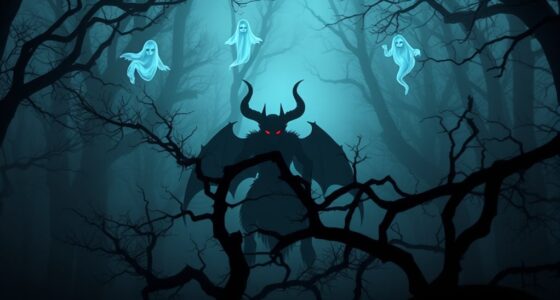Yes, there are both mythical vampires from folklore and real individuals who identify as vampires today. These real-life vampires may engage in practices like blood consumption for health and well-being. While legends mostly stem from Eastern European cultures, modern interpretations often show vampires as alluring figures in literature and media. If you’re curious about the diverse practices and intriguing history surrounding vampires, there’s so much more to explore!
Key Takeaways
- Vampires are both mythical beings from folklore and real individuals who identify as vampires in modern society.
- Approximately 5,000 people in the U.S. engage in vampire-related practices, often for health and well-being.
- Real-life vampires, known as sanguinarians, consume blood, while others may identify as psychic vampires drawing energy from others.
- Cultural representations of vampires have evolved, shifting from monstrous figures to complex characters in literature and media.
- Ethical considerations in the vampire community emphasize consent and respectful interactions during blood-feeding practices.
Defining Vampires: Myth vs. Reality
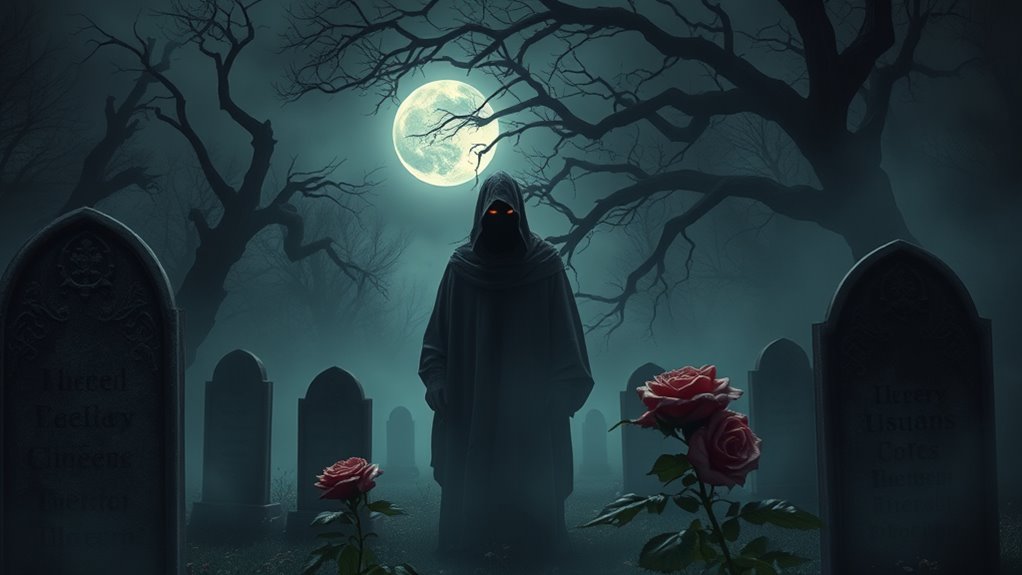
When you think of vampires, images of fanged creatures lurking in the shadows often come to mind, but the reality is much more complex.
Vampires, steeped in history behind folklore, can refer to both mythical beings and real vampires. The term emerged in the 1700s, linked to Eastern European legends. While Bram Stoker’s “Dracula” solidified the supernatural vampire image, modern vampires often identify differently.
You’ve got sanguinarians who drink blood, psychic vampires who feed on energy, and hybrids. With around 5,000 individuals in the U.S. claiming this identity, their practices can stem from various beliefs, sometimes tied to medical conditions or community rituals.
Understanding these nuances reveals the blurred line between myth and reality surrounding vampires today.
Historical Origins of Vampire Legends
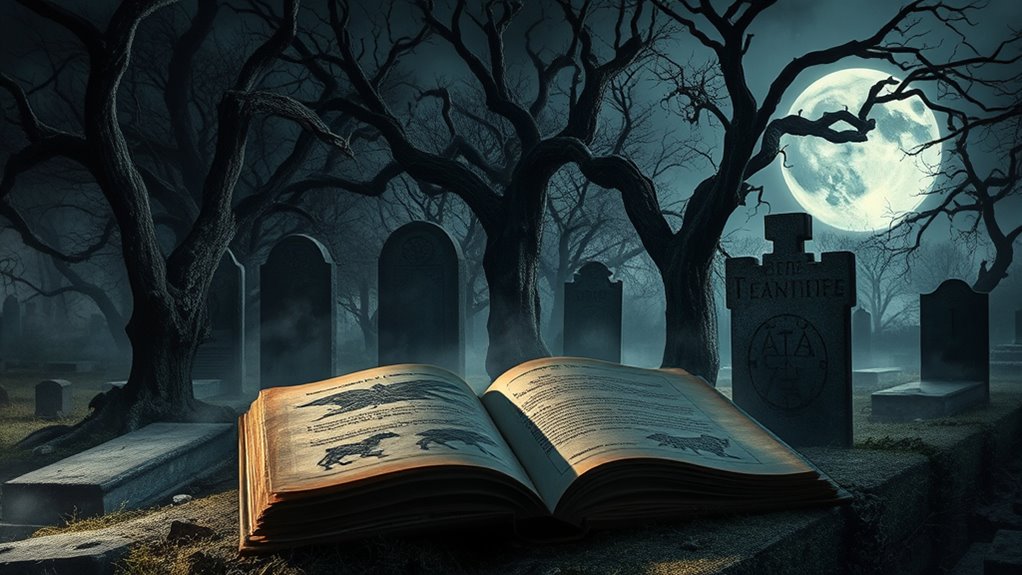
Although many associate vampires with gothic tales and horror films, their legends actually trace back to ancient folklore across various cultures. You’ll find that vampire myths have a fascinating history, especially in Eastern Europe, where tales of blood-drinking creatures flourished. The term “vampire” first emerged in English in the 1700s, initially describing price-gouging merchants. However, it’s Vlad the Impaler, a 15th-century ruler of Walachia, who’s often linked to Count Dracula due to his notorious bloodlust. John William Polidori’s novella introduced seductive vampires, while Bram Stoker’s “Dracula” solidified the grotesque image, blending supernatural powers with historical figures. The study of paranormal phenomena continues to reveal the enduring impact of these legends on modern culture.
| Vampire Legends | Cultural Origins |
|---|---|
| Ancient Folklore | Eastern Europe |
| Vlad the Impaler | Romania |
| Count Dracula | 19th Century Literature |
| Blood-Drinking Beasts | Global Myths |
| Supernatural Powers | Mystical Beliefs |
The Life of Vlad the Impaler: Inspiration Behind Dracula

Vlad the Impaler, a figure shrouded in brutality and legend, serves as the chilling inspiration for Bram Stoker’s Count Dracula.
As you explore his life, you’ll find that Vlad III ruled Walachia in the 15th century, notorious for his cruel methods of punishing enemies through impalement. His infamous bloodlust included dining among his victims, reportedly dipping bread in their blood, which cemented his brutal reputation.
The name “Dracula,” meaning “son of the dragon,” links him to his father’s ties with the Order of the Dragon, aimed at combating the Ottoman Empire.
Over time, the vampire legends surrounding Vlad the Impaler have evolved, intertwining his historical life with the mythos of vampirism, forever influencing Dracula’s character in literature.
Cultural Representations of Vampires in Media

How have cultural representations of vampires in media transformed over the years?
You’ll notice that vampires have shifted from grotesque, monstrous figures in Bram Stoker’s “Dracula” to alluring characters in popular culture, like those in Anne Rice’s “Interview with the Vampire.”
Rice introduced complex identities, showcasing vampires as beings torn between their thirst for human blood and their yearning for acceptance.
Bela Lugosi’s 1931 portrayal combined seduction with horror, influencing many adaptations.
The “Twilight” series further romanticized vampires, though critiqued for aligning them with mainstream values.
Today’s vampires often grapple with morality and the energy of others, reflecting deeper themes of identity and the struggle of being outsiders in a human world.
The Phenomenon of Real-Life Vampires

While the cultural portrayals of vampires in media paint a fantastical picture, there exists a real-life phenomenon of individuals who identify as vampires.
These people, often called sanguinarians, consume small amounts of blood, believing it’s essential for their well-being. Surveys suggest around 5,000 individuals in the U.S. identify as real vampires, many taking part in private feeding rituals to maintain their health.
Some report symptoms like physical fatigue and migraines when they don’t drink blood, prompting emergency medical attention.
The vampire community often remains private to protect their identities from stigma and misunderstanding, which adds to the complexity of their reality.
Understanding these real vampires challenges the myths and opens discussions about their unique experiences.
Ethical Considerations in the Vampire Community

In the vampire community, ethical considerations revolve around feeding practices and the necessity of consent from donors.
You’ll find that many real vampires follow community guidelines to guarantee a respectful exchange, balancing their needs with the well-being of others.
However, public perception often complicates these practices, leading to misunderstandings about what it means to be a vampire today.
Feeding Practices and Consent
Understanding ethical feeding practices in the vampire community requires recognizing the importance of consent and donor welfare. Real vampires often engage in sanguinarian (blood feeding) or psychic (energy feeding) practices, each governed by unique ethical considerations.
Most prefer to feed in crowded environments, where they can take small amounts from willing donors, minimizing harm. Clear communication and enthusiastic consent are vital in these interactions, as many vampires view their donors as friends or partners.
For psychic vampires, venues like concerts create a consensual atmosphere for energy exchange. Ultimately, ethical considerations emphasize respect for autonomy, ensuring that donors willingly participate in feeding rituals. This reinforces informed consent, making it a cornerstone of the vampire community’s feeding practices.
Community Ethical Guidelines
As the vampire community continues to grow, establishing clear ethical guidelines becomes essential for nurturing a respectful and safe environment.
Ethical feeding practices center around consent, ensuring that donors willingly participate in energy exchange. Most vampires prefer to feed in crowded venues, like concerts, where they can draw energy without directly confronting ethical dilemmas.
Building trust is crucial, so many vampires seek donors among friends or acquaintances. Before engaging in feeding rituals, they discuss boundaries and expectations with donors, promoting a culture of respect.
Transparency about these practices helps combat stigma and fosters understanding, allowing the community to redefine societal perceptions of vampirism through ethical engagement.
Public Perception Challenges
Public perception of the vampire community often presents significant challenges, largely due to widespread misconceptions and stigma. Many people believe vampires might be dangerous or mentally unstable, which isn’t true for most self-identified real vampires.
In reality, they engage in ethical feeding practices, taking blood or energy from willing donors in safe environments, ensuring consent and minimizing harm. Misunderstandings lead to discrimination, particularly when accessing healthcare.
The community emphasizes informed consent and the well-being of donors, aiming for a respectful dynamic. Conversations about their existence can foster greater understanding and acceptance, highlighting the complexities of their identities and ethical dimensions of their practices.
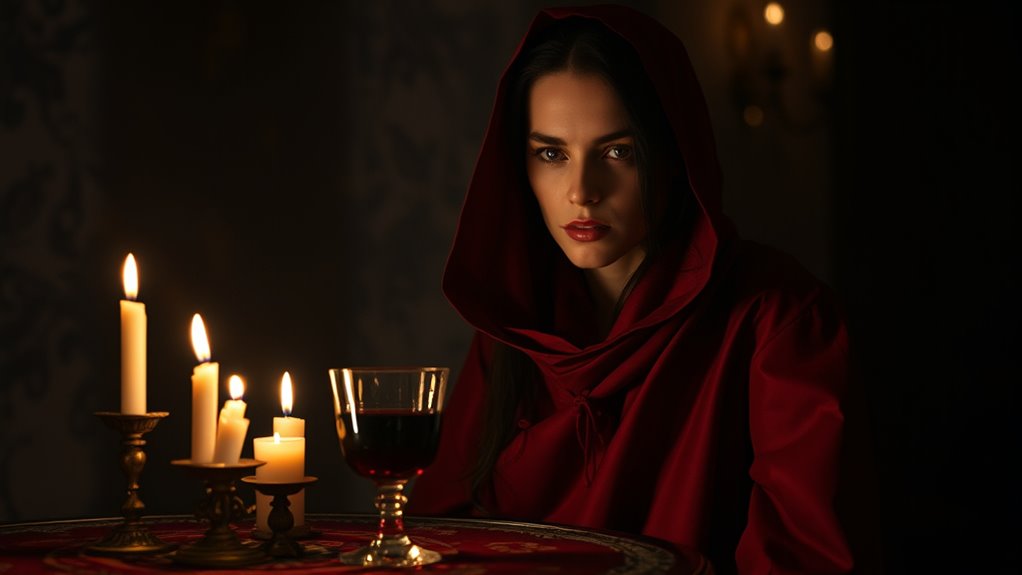
Though often seen as sinister figures, vampires captivate us because they embody the allure of rebellion and individuality. This fascination stems from deep psychological interests and societal desires for freedom.
Many individuals identify as real vampires, exploring darker aspects of human nature through a contemporary lens.
Many embrace the identity of real vampires, delving into the shadows of human nature through a modern perspective.
- Immortality and its implications
- Forbidden desires that challenge norms
- The search for belonging in a misunderstood subculture
- Ethical feeding practices redefining the vampire mythos
- The connection between fantasy and personal identity
These elements resonate with you on a subconscious level, reflecting a need for understanding the unknown.
As you navigate complex realities, the allure of vampires offers a unique space for exploration and acceptance.
Places Associated With Vampire Lore and Legends
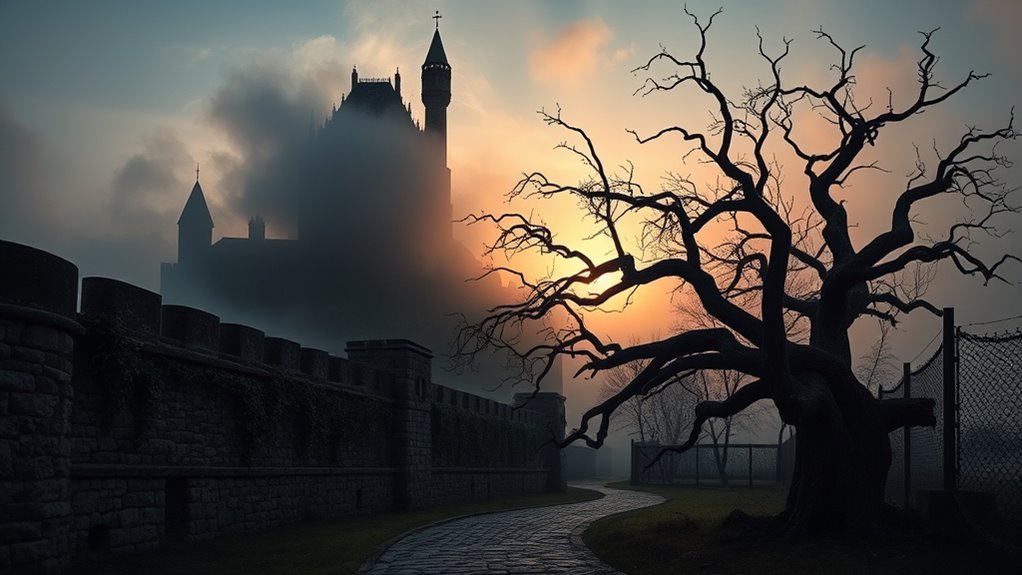
The fascination with vampires extends beyond psychology and culture; it manifests in the very places that fuel our imaginations.
In Transylvania, vampires can be found lurking in the shadows of Bran Castle, famously linked to Bram Stoker’s “Dracula” and Vlad the Impaler. This region is a hub for vampire lore, drawing tourists enthusiastic to explore its dark history.
Meanwhile, New Orleans thrives with a vibrant vampire subculture, influenced heavily by Anne Rice’s “Interview with the Vampire,” where events like the annual Vampire Ball celebrate the undead.
Salem, Massachusetts, known for its witch trials, also weaves vampire legends into ghost tours.
Even Venice, Italy, holds tales of blood-drinking spirits, enriching the global tapestry of vampire folklore.
Frequently Asked Questions
Are There Real Vampires?
Yes, there are individuals who identify as real vampires.
You might find that some consume blood, while others draw energy from people around them.
These self-identified vampires often claim they experience health issues when they don’t “feed,” and engaging in these practices alleviates their symptoms.
The community tends to be private, so you may not often encounter them, but their existence challenges traditional views on identity and normalcy.
Can a Human Become Vampire?
Imagine feeling an insatiable hunger for something beyond mere food. Can you really transform into a vampire? The answer’s no.
While some identify as “real vampires” and seek energy or blood from others, this isn’t a supernatural change. They often experience fatigue that leads them to these practices, but it doesn’t grant them any mythical powers.
Instead, it highlights a unique subculture, rooted more in identity than any biological reality.
Who Is the First Real Vampire?
You might wonder who the first real vampire is. While there’s no definitive answer, many point to figures like Vlad the Impaler, whose brutal reputation fueled vampire lore.
However, the modern concept of a “real vampire” emerged from the 18th and 19th centuries, particularly with stories like John William Polidori’s “The Vampyre.”
Today, some individuals identify as real vampires, claiming a need for blood or energy, illustrating the evolving nature of this fascinating subculture.
In Which Country Did Vampires Exist?
Picture a world where vampires roam freely, sipping coffee in Romania’s Transylvania or lounging on a beach in Trinidad and Tobago.
You’ll find them in Greece, rising from their graves as vrykolakas, and in Mexico City, where chupacabras lurk in the shadows.
Iceland’s draugr mightn’t drink blood, but they sure know how to keep things interesting.
Conclusion
In exploring the world of vampires, you’ve uncovered a tapestry woven with myth, history, and cultural fascination. While the supernatural creatures may not roam the night, their allure persists in our imaginations. Aren’t we all drawn to the idea of immortality, escaping the mundane? Whether as symbols of fear or desire, vampires reflect our deepest fears and yearnings. So, as you close this chapter, remember: the line between reality and myth is often just a shadow in the dark.


